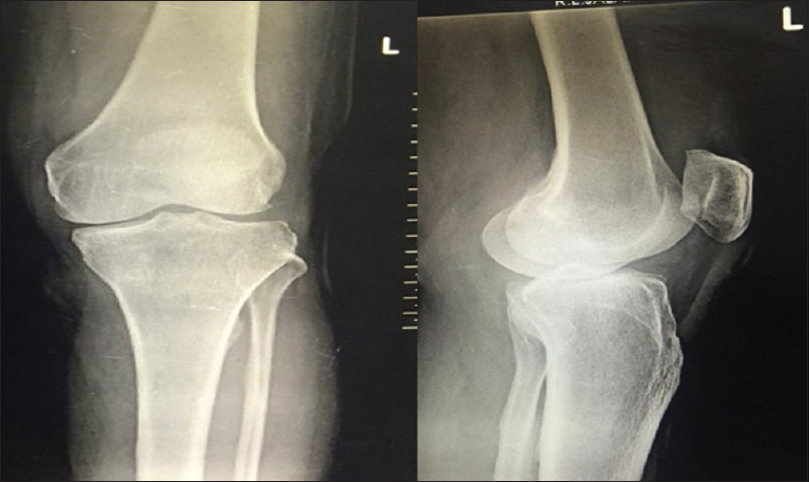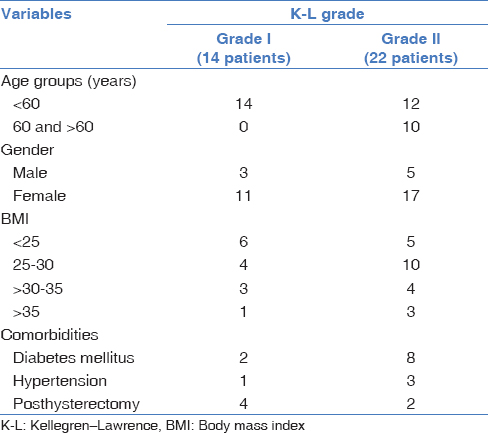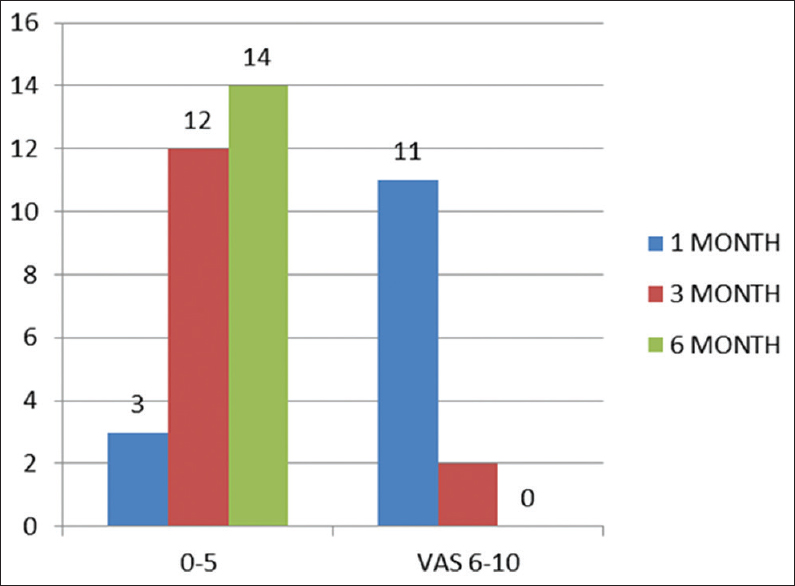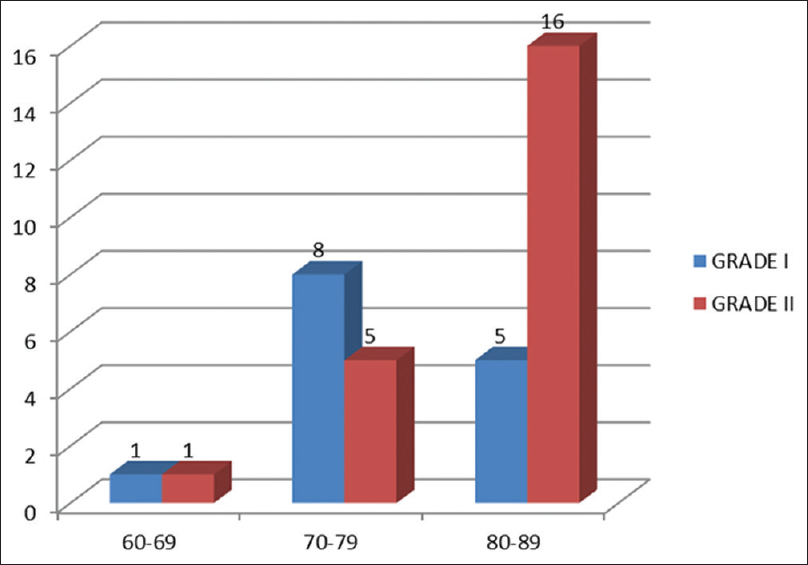Translate this page into:
A study on the effectiveness of visco-supplementation in osteoarthritis knee
Address for correspondence: Dr. H. S. Arun, Department of Orthopaedics, Sri Devaraj Urs Medical College, Tamaka, Kolar - 563 101, Karnataka, India. E-mail: drarunhs5@gmail.com
-
Received: ,
Accepted: ,
This article was originally published by Wolters Kluwer - Medknow and was migrated to Scientific Scholar after the change of Publisher.
How to cite this article: Sivanandan S, Arun HS, Seenappa H, Nagakumar JS. A study on the effectiveness of visco-supplementation in osteoarthritis knee. J Orthop Spine 2020;8:70-4.
Abstract
BACKGROUND:
Osteoarthritis (OA) is a degenerative disease of synovial joints; recently, it is also termed osteoarthrosis. High-molecular-weight hyaluronic acid (HA) has a better increase in fluid retention within the joint and stronger anti-inflammatory effect.
OBJECTIVES:
The objective was to assess the efficacy of intra-articular (IA) HA in primary OA of knee joint based on clinical outcome with visual analog score (VAS) and the Western Ontario and McMaster Universities OA Index (WOMAC) score and to determine the safety of IA HA in primary OA of knee joint.
SUBJECTS AND METHODS:
A single-group, prospective interventional study was conducted from November 2017 to May 2019 in a tertiary care hospital. A total of 36 patients with Grades I and II of Kellegren–Lawrence radiological grading were included in the study. IA injection of HA was given to these patients and were assessed using VAS and WOMAC scores.
RESULTS:
The mean VAS scores improved from preinjection score of 9.03 ± 0.94 to 2.61 ± 2.15 at 6-month follow-up. In addition, the mean WOMAC scores improved from 81.14 ± 6.43 to 35.81 ± 13.44 at 6-month post-IA HA injection.
CONCLUSIONS:
This study observed that IA injection of HA is a reliable, productive, efficient, and safe mode of treatment of Grade I and II OA knee, which also delays the disease and reduces the need for surgical intervention.
Keywords
Hyaluronic acid
osteoarthritis
visual analog score
Western Ontario and McMaster Universities Osteoarthritis Index Score
Introduction
Osteoarthritis (OA) is a degenerative disease of synovial joints; recently, it is also termed osteoarthrosis.[1] It is a progressive degenerative condition in which it affects most parts of synovium, ligaments around the joint, meniscus, and bones in the subchondral region along with loss in the articular cartilage.[2]
Osteoarthritis is a most common disabling joint disease compared to rheumatoid arthritis.[3] It is among the ten leading causes of disability worldwide. Its etiology is multifactorial and divided into local and systemic factors that include local trauma, obesity, synovitis, low-grade inflammation, and diabetes.[4] Knee OA increases with age; about 11% of all women over the age of 60 years have symptoms due to OA knee. Nearly 40% of the Indian population above the age of 70 years suffer from OA knee.[5]
There is clinical evidence to suggest that the risk for developing OA can be mitigated and reduced by weight management, avoiding obesity/overweight, maintaining high levels of mobility, and avoiding sedentary lifestyles. The primary aim of OA management is to control the noxious signals originating from joints. Similarly, it serves in such a way to improve the quality of life. Nonpharmacological therapy was the preferred first line of treatment. Pharmacologic therapies can be summarized as nonsteroidal anti-inflammatory drugs, opioid, and analgesics. If orally administered, drugs are ineffective; intra-articular (IA) injection (corticosteroids, visco-supplements, and blood-derived products) is the last nonsurgical treatment option that could be preferred. With the intention to stop and revert the degeneration, IA injections of autologous conditioned serum, platelet-rich plasma, and mesenchymal stem cell were experimented.[6]
Hyaluronic acid (HA) produced by B cells of synovial membrane is biochemically a high-viscosity polysaccharide also classified in glycosaminoglycan group.[7] High-viscosity solution is formed by interlinking high-molecular-weight (MW) molecules. This high-viscosity solution acts both as a lubricant and a shock absorber. It has a MW of 4,000,000–10,000,000 Da. A normal adult knee has approximately 2 mL of synovial fluid and 2.5–4.0 mg/mL of HA. In OA, synovial HA is depolymerized (MW, 2700–4500 kDa) and cleared at higher rates (11–12 h) than normal (20 h).[8,9] HA action is by inhibition of the actions of pro-inflammatory mediators and pain-producing neuropeptides released by activated synovial cells.
Subjects and Methods
A single-group, prospective interventional study was done during the period of November 2017 to May 2019. All the OA knee patients reported to the outpatient department of orthopedics attached to the tertiary care center were enrolled in the study. The study was started after obtaining institutional ethical clearance no. SDUMC/KLR/IEC/39/2017-18 dated November 29, 2017.
A total of 36 patients of either gender with knee OA of Kellegren–Lawrence (K-L) Grade I [Figure 1] and Grade II [Figure 2] belonging to the age group of 40–80 years were recruited with a history of failed conservative treatment for 3 months. Patients with a clinically apparent tense effusion of the target knee, ligamentous laxity or meniscal instability, concomitant inflammatory disease (rheumatoid arthritis) or other condition that affects the joints, any trauma history to the knee, and any previous surgeries to the knee were excluded from the study.

- Radiograph (anteroposterior and lateral view) of the left knee joint of the patient with Kellegren and Lawrence Grade 1 with mild joint space narrowing

- Radiograph (anteroposterior and lateral view) of the left knee of the patient with Grade 2 osteoarthritis knee with joint space narrowing and osteophytic lipping
A single-shot prefilled 4 ml of HA (highly cross-linked, high-MW [>6000 kDa]) which costs around Rs. 5000 for research purpose was supplied on the date of injection by a medical representative with maintenance of cold chain around 2°C–8°C. Under aseptic precautions, IA HA injection was given with the patient in supine position and knee in slight flexion superolaterally. Post injection, passive range of movements were done and Jones compression bandage was applied. The protocol after the intra-articular injection included life-style modifications such as weight reduction and quadriceps exercises. The patient were allowed weight bearing as tolerated on the same day. The patients were discharged on the same day with an advice to do static and dynamic quadriceps exercises at home and were allowed to resume their daily activities as per tolerance. In a short-term follow-up till 6 months, the patients were clinically and functionally assessed using the visual analog score (VAS) and Western Ontario and McMaster Universities OA Index (WOMAC) score at 1, 3, and 6 months. Data was analyzed using SPSS version 22 software (Anika therapeutics, Bedford, USA). Calculations were analyzed using the repeated ANOVA test.
Results
Among the 36 cases, 14 cases were having K-L Grade I OA and 22 cases belonged to Grade II OA. Most of the patients aged <60 years had both Grades I and II, whereas Grade II OA was more common in the elderly aged >60 years. There were 8 male and 28 female patients. Out of the total eight males, five patients were in Grade II and only three males were in Grade I. Out of the 28 females, 17 patients had Grade II OA and 11 patients belonged to Grade I OA knee. Females were commonly affected than males.
Body mass index (BMI) is an important risk factor for OA knee as evident from previous studies. We also had patients with increased BMI in both grades. Two-thirds of our patients had BMI >25, in which four patients were morbidly obese, 7 were obese, and 14 were overweight. Among these patients with deranged BMI, about 50% belonged to overweight category with a BMI of 25–30 kg/m2. Two patients in Grade I and eight patients in Grade II had diabetes mellitus as the commonly associated comorbid factor for OA knee that may lead to more cartilage damage and increase the damage with glycation end products.
The other commonly noted comorbidities included hypertension in four patients and posthysterectomy in six patients. The high incidence of osteoarthritis in 6 patients aged <50years, who underwent hysterectomy for different etiologies correlates with decreased estrogen among them [Table 1].

The VAS score ranged from 0 to 10, which was calculated at the primary visit and during follow-up at 1, 3, and 6 months after injection. The improved functional outcomes were defined by the progressive decrease in the mean VAS scores at the follow-up periods. In our study, the mean VAS score at preinjection was 9.03 ± 0.94 and at the 1st-month follow-up post injection, it was 6.75 ± 1.31. It progressively decreased further during the 3rd- and 6th-month follow-up to 4.58 ± 1.16 and 2.61 ± 2.15, respectively. Nine (64%) Grade I OA patients had VAS scores of 8, in comparison to 14 (63%) Grade II OA patients who had extreme pain with a VAS score of 10 [Figure 3]. The VAS scores in all patients with Grade I OA knee improved with a score <5 at the end of 6 months [Figure 4], as compared to improvement of VAS score in Grade II OA knee patients, in which about 1/3rd of them still persisted with a VAS score >5 at the end of 6-month follow-up [Figure 5].

- Bar diagram showing the preinjection visual analog scores in the osteoarthritis patients

- Bar diagram represents the post-intra-articular hyaluronic acid injection visual analogue scores in Grade I osteoarthritis patient

- Bar diagram represents the post-intra-articular hyaluronic acid injection visual analogue scores in Grade II osteoarthritis patients
The WOMAC score ranged from 0 to 96, which was calculated at the primary visit and during follow-up at 1, 3, and 6 months after injection. The improved functional outcome was defined by the progressive decrease in the mean WOMAC scores at the follow-up periods.
In our study, the mean WOMAC score at preinjection was 81.13 ± 6.43 and at 1st-month follow-up post injection, it was 65.14 ± 7.20. It progressively decreased further during the 3rd- and 6th-month follow-up to 50.19 ± 10.5 and 35.80 ± 13.44, respectively. Thirteen of the 14 Grade I OA patients (93%) had improved WOMAC scores (30–60) as compared to their preinjection values (60–90). Twenty-one of the total 22 Grade II OA patients (95%) had improved WOMAC scores (30–60) compared to their preinjection WOMAC scores (60–90) [Figures 6 and 7].

- Bar diagram showing the preinjection Western Ontario and McMaster Universities osteoarthritis index scores in the osteoarthritis patients

- Bar diagram depicting Western Ontario and McMaster Universities osteoarthritis index scores of both grade osteoarthritis knee patients at 6 months after the injection of hyaluronic acid
The VAS score ranged from 0 to 10. In our study, the mean VAS score at preinjection was 9.02, post 1 month was 6.75, at 3rd month it improved to 4.58, and at around 6 months, it decreased to 2.6. The pain significantly reduced in all of the patients when assessed with the mean VAS at the end of 6-month follow-up. Statistical analysis done by Wilks' Lambda multivariate test for both VAS and WOMAC scores showed a significant difference between pre- and post-injection scores at the follow-up periods of 1 month, 3 months, and 6 months. P <0.001 showed a statistically significant decrease in the scores [Table 2].

Discussion
Osteoarthritis is the most common disabling joint disease than rheumatoid arthritis. It is among the ten leading causes of disability worldwide. There is clinical evidence to suggest that the risk for developing OA can be mitigated and reduced by weight management, avoiding obesity/overweight, maintaining high levels of mobility, and avoiding sedentary lifestyles. Recently, IA high-MW HA injection is becoming a popular intervention in Grade I and II OA knee patients.
The mean age of patients in our study was 57.4 ± 9.45 years. It was comparable with that of other studies by Pal et al.[10] and Das et al.,[11] with mean age of 57.4 ± 9.05 and 59.83 ± 10.73 years, respectively. The incidence of OA is more common in females (77.8%) than males (22.2%). This incidence is comparable with other studies done by Pal et al.,[10] with a sex incidence of female: male ratio of 58%:42%, and by Das et al.[11] which had a female: male ratio of 53.3%:46.7%.
In our study, 22 patients(61.11%) were having K-L grade-II OA knee and 14 patients(38.89%) belonged to K-L grade-I OA knee, which was comparable with the findings of Pal et al.,[10] which had 48.3% in Grade 1 and 51.7% in Grade 2.
The mean VAS score in our study prior to injection was 9.03, which was comparable to other studies by Bowman et al.,[12] with a mean value of 6.1. In addition to this, the mean VAS score in our study at 6 months was 2.61, whereas in a study by Bowman et al.,[12] the mean score was 5.9 at the end of 6 months.
The mean WOMAC score in our study pre injection was 81.14, which is comparable with other studies such as those by Pal et al.,[10] and Das et al.,[11] with a mean of 71.9 and 58.83, respectively. At 6 months post injection, the mean WOMAC score was 35.81 in our study, which is comparable to the mean WOMAC scores of the studies by Pal et al.[10] and Das et al.,[11] who had WOMAC scores of 28.2 and 28.43, respectively [Table 3].

Limitations
Our study had some limitations; though it was prospective in nature, the study was done for a shorter duration of time with limited sample size. Further randomized controlled trials with larger sample size and longer follow-up are needed to draw conclusive recommendations. Addition of magnetic resonance imaging of knee will aid in the understanding of cartilage degeneration and also will help in assessing the regeneration of cartilage.
Conclusions
OA of the knee joint is a common disorder often characterized by pain, cartilage damage, and joint dysfunction. Although the role of HA in OA knee is still not promising than expected, its role in the treatment cannot be refused without acknowledging. Our study showed significant reduction of pain with functional improvement in all the patients as assessed by VAS and WOMAC score. The functional outcome of Grade II OA knee patients was similar compared to that of Grade I OA knee patients. This study observed that IA injection HA is a reliable, productive, efficient, and safe mode of treatment of Grade I and II OA knee, which also delays surgical intervention. Pain at the injection site was self-limiting and resolved without any medication. This injection has slow onset of action but the effect stays for 6 months.
Financial support and sponsorship
Self-funded.
Conflicts of interest
There are no conflicts of interest.
References
- Osteoarthritis as an inflammatory disease (osteoarthritis is not osteoarthrosis!) Osteoarthritis Cartilage. 2013;21:16-21.
- [CrossRef] [PubMed] [Google Scholar]
- Articular cartilage: Degeneration and osteoarthritis, repair, regeneration, and transplantation. Instr Course Lect. 1998;47:487-504.
- [Google Scholar]
- The global burden of hip and knee osteoarthritis: Estimates from the global burden of disease 2010 study. Ann Rheum Dis. 2014;73:1323-30.
- [CrossRef] [PubMed] [Google Scholar]
- Intraarticular injections (corticosteroid, hyaluronic acid, platelet rich plasma) for the knee osteoarthritis. World J Orthop. 2014;5:351-61.
- [CrossRef] [PubMed] [Google Scholar]
- Efficacy. Tolerability and adverse events of single-shot intra-articular hyaluronic acid injection in knee osteoarthritis. J Trauma Treat. 2015;4:1-5.
- [CrossRef] [Google Scholar]
- Low-grade inflammation as a key mediator of the pathogenesis of osteoarthritis. Nat Rev Rheumatol. 2016;12:580-92.
- [CrossRef] [PubMed] [Google Scholar]
- Metabolic engineering of Escherichia coli for biosynthesis of hyaluronic acid. Metab Eng. 2008;10:24-32.
- [CrossRef] [PubMed] [Google Scholar]
- Viscosupplementation: A new concept in the treatment of osteoarthritis. J Rheumatol Suppl. 1993;39:3-9.
- [Google Scholar]
- Use of sodium hyaluronate. (Hyaluronan) in equine joint disease. Equine Vet Educ. 1997;9:296-304.
- [CrossRef] [Google Scholar]
- Therapeutic efficacy of intra-articular hyaluronic acid in osteoarthritis knee. J Bone Joint Dis. 2017;32:44-9.
- [Google Scholar]
- How efficacious are intra-articular viscosupplements in the management of early osteoarthritis knee? A detailed comparative study with various outcome measures. Int J Orthopaed Sci. 2017;3:426-30.
- [CrossRef] [Google Scholar]
- Hyaluronic acid injections for osteoarthritis of the knee: Predictors of successful treatment. Int Orthop. 2018;42:733-40.
- [CrossRef] [PubMed] [Google Scholar]






